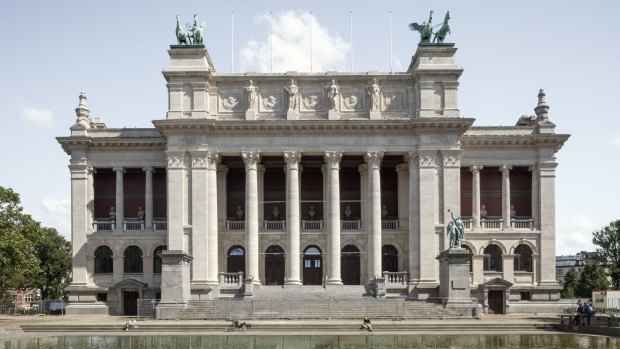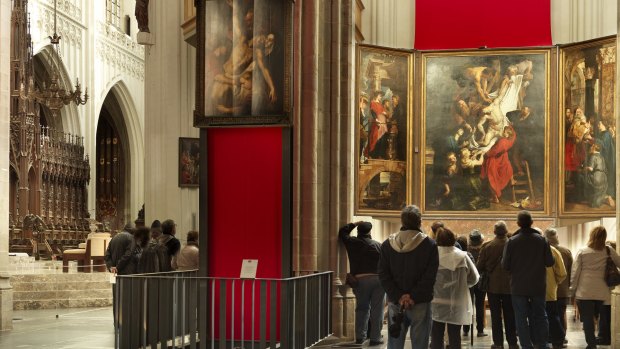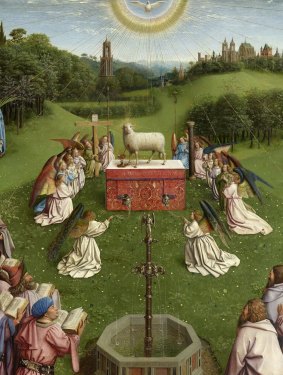This was published 1 year ago
Royal Museum of Fine Arts reopens in Antwerp, Belgium and Flemish art in Ghent, home to the most stolen artwork of all time
By Anabel Dean

The Royal Museum of Fine Arts in Antwerp.
The bells are ringing in Antwerp. Dong. Dong. Dong.
The clanging melody peals from belfry to cobblestones, gathers speed along the rows of ornate guild-houses, hurtles giddily towards a miraculous happening.
Antwerp has been waiting for this moment for more than a decade. And not even the rain that's pelting down like Belgian bullets will stem the tide of citizens flowing towards boulevard Leopold de Waelplaats.

Our Lady Cathedral, Antwerp.
One of Belgium's most important art galleries, the Royal Museum of Fine Arts, has finally opened its doors after being closed for renovation for 11 years.
The bells tolled like this two centuries ago when Paris returned Napoleon's stolen art treasury to Antwerp after his defeat at Waterloo. Apparently Napoleon didn't think much of Antwerp - "Scarcely a European city at all" - but he still snatched the Golden Age of Flemish art for his national museum of France which eventually became The Louvre.
Now the ribbon is cut and generations of art-loving Antwerpians are in festival mode, popping champagne in the museum forecourt and striding up the grand staircase into a new world. Artworks of the past, even if collected by princes, belong to the people.

The Adoration of the Mystic Lamb (1432), known as The Ghent Altarpiece, was meticulously restored over seven years and is now suspended in a €5 million bullet-proof display case in St Bavo's Cathedral.Credit: KMSKA
On the outside, the colossal limestone facade, with its neoclassical columns and triumphal bronze chariots, looks pretty much the same as it did when first opened in 1890. On the inside, it's a different story, with two distinct realms merged into one almighty temple of art (known by its Flemish acronym as KMSKA).
Walk through the restored old Flemish masters' galleries and an ethereal white "stairway to heaven" leads into a slick, modernist marvel that fits seamlessly within the original building. Bright white cubes with white poured-resin floors reflect daylight from triangular windows angled high into the sky.
By European standards, the art collection of KMSKA is small - only 8400 works – a museum on the human scale where quality counts. The collection spans seven centuries of art amassed since the 14th century and offers an almost complete overview of Flemish and Belgian art from the great primitives - Hans Memling and Jan van Eyck – through to Jan Gossaert and Pieter Bruegel the Elder, Anthony van Dyck, Pieter Paul Rubens and Jacob Jordaens.
Jean Fouquet's extraordinary "Madonna Surrounded by Seraphim and Cherubim" (1452) has been described as "the Mona Lisa of Antwerp". There are seminal works by Titian, Rembrandt, Rodin, Modigliani ("Seated Nude"), Magritte ("The Sixteenth of September") and the largest collection of works by the enigmatic Belgian expressionist James Ensor.
Great public museums are more than just a hoard of artefacts; they're an expression of cultural power. And in pride of place, there is Antwerp's most celebrated son, Rubens.
The immense 15-metre-high Rubens Room has been polished into a dizzy fantasy of monumental church paintings: Madonna and Child Enthroned with Saints, The Adoration of the Magi and The Baptism of Christ. Incredibly, prodigious pieces like these - too large to fit through the doors or too fragile to move - were lowered through hatches in the floor to be concealed beneath the building while construction was underway.
Conservators tell of miraculous restoration stories (more than 130 works have now been revived) but the prize probably belongs to Hans Memling's staggeringly beautiful God the Father with Singing and Music-making Angels (1494). It took 16 years for the custodians to eradicate the thick insoluble salt crust on the surface of the work, removed millimetre by millimetre, through the lens of a microscope.
Despite all its artsy and architectural splendour, and a Lonely Planet tagline as "the most consistently cool city on the planet", Antwerp has an undeservedly low profile as a travel destination in Dutch-speaking Flanders.
The pocket-sized metropolis roped to an estuary of the river Scheldt is the second largest port in Europe. It embraces all the qualities expected of Belgium: chocolate boxes and beer goblets, trams and frites, vibrant street life with edgy boutiques and bustling concept stores. The stylish and relevant cult fashion museum, Mode Museum (MoMu), has just reopened after a three-year facelift.
Today Antwerp is an economic powerhouse fuelled by fashion, diamonds and petrochemicals but, for most of the 16th century, it was the hub of the Western world. Ideas, information, goods and money circulated free of almost any authority here, and the city was the crucible of exciting artistic achievements, fortified by an almost insatiable demand for embellishment of churches and mansions.
Rubens was a Baroque superstar in a thriving community of great painters (Bruegel, Anthony Van Dyck, Frans Hals and Rogier van der Weyden) who were either born or flourished in the city. Much of the generated wealth was poured into beautification of the city: the magnificent Grote Markt square with its grand city hall flanked by high-gabled houses; and the Cathedral of Our Lady that was 170 years in the making.
Visitors still flock to the seven-aisled cathedral for whispered worship of hypnotic triptychs that have survived centuries of looting and conflict. Rubens's phenomenal masterpieces - The Elevation of the Cross (1610) and The Descent from the Cross (1612) - hang at the entrance to the chancel in the exact spot intended by the artist.
There are other places of pilgrimage, finely endowed museums outside the churches and galleries, such as the Rubens House. The building, rescued from dereliction in 1937, was bought by the artist in 1610 on his return from Rome, then converted into a lavish Italian palazzo. Rubens was not an artist who suffered for his art. He was a diplomat mixing with the highest political and social circles and made a fortune churning out commissions from this busy studio (closed for renovations from January next year).
Enlightenment endures in another incredible but little-known World Heritage jewel known as The Museum Plantin-Moretus. The great European printing house, founded in 1576, is as mesmerising as a Rubens altarpiece.
Dark timbered rooms wallpapered in gilt-embossed leather display relics of the printing revolution, including the world's two oldest surviving printing presses dating from about 1600, and the astonishing eight-part Royal Bible in five languages. The knowledge secreted within these books, maps, paintings and manuscripts is simply unfathomable.
There are too many reasons to linger in Antwerp, but another artistic revelation awaits in one of Belgium's oldest cities, an easy hour away by train.
Ghent is a spectacle of canal-side medieval architecture shouldered against gritty post-industrial areas of cool urban renewal. A large student population ensures vibrancy in the quirky bars and cosy restaurants dotted about the city. One of the best bookshops in the world is here - Bookz & Booze is an object lesson on pairing good books with good bottles - but it's not the real reason for coming to Ghent.
This is the home of the Flemish genius who revolutionised painting in the 15th century.
Jan van Eyck's ultimate masterpiece - completed after the death of his older brother, Hubert, in 1426 - is one of Belgium's national treasures. The Adoration of the Mystic Lamb (1432), known as The Ghent Altarpiece, was meticulously restored over seven years and is now suspended in a €5 million bullet-proof display case in St Bavo's Cathedral.
It almost didn't make it this far as the most stolen artwork of all time. The work was winched away from flames lit by rioting Calvinists, cut in half by the King of Prussia, nicked by Napoleon, then returned thanks to the Duke of Wellington. It was hidden by Hitler in an Austrian salt mine, where it might have been blown up by dynamite, had it not been rescued by a team of silent heroes. One panel, stolen in 1934, is still missing.
A visitor centre inside St Bavo's Cathedral helps bring the piece to life with an augmented-reality digital experience that immerses in the world of Van Eyck.
The allegorical glorification of Christ's death sprang from nowhere after centuries of highly stylised Medieval Art. Van Eyck transformed painting with his hyper-realistic, technically brilliant use of oils, perspective and reflection.
The 12 panels - which include the first monumental painted nudes of the Renaissance in Adam and Eve - capture the miraculous diversity of the natural world in a way previously unknown. The work is chocked full of the trickery and symbolism of the old age but the mystical sorcery is every bit as beguiling in the new age.
Images of the altarpiece went viral when conservators removed centuries of over-painting to reveal Van Eyck's original "humanoid" depiction of the Lamb of God, standing on an altar in the middle of a meadow, blood gushing into a golden goblet.
This is the masterpiece that altered the course of Western art.
If ever there was a reason to ring the bells, it's right here, in this quiet corner of a Flanders cathedral.
A leisurely walk through KMSKA in the Het Zuid district of Antwerp will take about two hours. Tickets 20€ (adults), 10€ (under 18-26 years). See https://kmska.be/en
The Rubens House is renovating but remains open until January 8, 2023. Tickets at front desk - €12 (adults), €8 (18-25 years) - otherwise in advance online. See https://rubenshuis.be
Open the door to Museum Plantin-Moretus and you'll feel as if you're visiting the Plantin-Moretus family 400 years ago. Tickets €12 (adults), €8 (18-25 years). See https://museumplantinmoretus.be
Faith has been shaped for 500 years in The Cathedral of Our Lady where a visit that includes the Rubens masterworks costs €12/pp. See https://www.dekathedraal.be
Saint Bavo's Cathedral in Ghent is accessible every day (except January 1) for an augmented reality tour with a visit to the altarpiece for 16€ (adults), 8€ (under 12-years). See https://www.sintbaafskathedraal.be/
EAT
Somewhere special, try the new Fiera, in the ornate old stock exchange building. See https://fiera.be/
Experience Het Leienpaleis, a mansion recently reopened after a stylish refurbishment by Flemish interior designer Gert Voorjans. See https://www.leienpaleis.be/
Anabel Dean travelled as a guest of Visit Flanders.
Sign up for the Traveller Deals newsletter
Get exclusive travel deals delivered straight to your inbox. Sign up now.